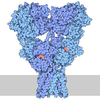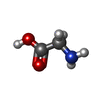[English] 日本語
 Yorodumi
Yorodumi- PDB-4buo: High Resolution Structure of Thermostable Agonist-bound Neurotens... -
+ Open data
Open data
- Basic information
Basic information
| Entry | Database: PDB / ID: 4buo | ||||||
|---|---|---|---|---|---|---|---|
| Title | High Resolution Structure of Thermostable Agonist-bound Neurotensin Receptor 1 Mutant without Lysozyme Fusion | ||||||
 Components Components |
| ||||||
 Keywords Keywords | SIGNALING PROTEIN / G PROTEIN COUPLED RECEPTOR / MEMBRANE PROTEIN | ||||||
| Function / homology |  Function and homology information Function and homology informationregulation of locomotion involved in locomotory behavior / Peptide ligand-binding receptors / positive regulation of locomotion / neuropeptide receptor binding / G protein-coupled neurotensin receptor activity / regulation of inositol trisphosphate biosynthetic process / inositol phosphate catabolic process / symmetric synapse / D-aspartate import across plasma membrane / positive regulation of gamma-aminobutyric acid secretion ...regulation of locomotion involved in locomotory behavior / Peptide ligand-binding receptors / positive regulation of locomotion / neuropeptide receptor binding / G protein-coupled neurotensin receptor activity / regulation of inositol trisphosphate biosynthetic process / inositol phosphate catabolic process / symmetric synapse / D-aspartate import across plasma membrane / positive regulation of gamma-aminobutyric acid secretion / regulation of membrane depolarization / positive regulation of arachidonate secretion / vocalization behavior / response to antipsychotic drug / neuron spine / L-glutamate import across plasma membrane / regulation of behavioral fear response / regulation of respiratory gaseous exchange / neuropeptide hormone activity / cAMP biosynthetic process / positive regulation of inhibitory postsynaptic potential / negative regulation of systemic arterial blood pressure / negative regulation of release of sequestered calcium ion into cytosol / digestive tract development / G alpha (q) signalling events / positive regulation of glutamate secretion / hyperosmotic response / response to mineralocorticoid / response to food / response to corticosterone / cellular response to lithium ion / temperature homeostasis / response to lipid / positive regulation of inositol phosphate biosynthetic process / detection of temperature stimulus involved in sensory perception of pain / response to stress / associative learning / conditioned place preference / cellular response to dexamethasone stimulus / neuropeptide signaling pathway / response to axon injury / transport vesicle / axon terminus / response to amphetamine / blood vessel diameter maintenance / positive regulation of release of sequestered calcium ion into cytosol / dendritic shaft / adult locomotory behavior / learning / response to cocaine / liver development / cellular response to nerve growth factor stimulus / visual learning / cytoplasmic side of plasma membrane / terminal bouton / response to estradiol / perikaryon / dendritic spine / positive regulation of phosphatidylinositol 3-kinase/protein kinase B signal transduction / positive regulation of apoptotic process / receptor ligand activity / membrane raft / negative regulation of gene expression / axon / neuronal cell body / dendrite / positive regulation of gene expression / negative regulation of apoptotic process / protein-containing complex binding / cell surface / extracellular region / identical protein binding / plasma membrane Similarity search - Function | ||||||
| Biological species |  | ||||||
| Method |  X-RAY DIFFRACTION / X-RAY DIFFRACTION /  SYNCHROTRON / SYNCHROTRON /  MOLECULAR REPLACEMENT / Resolution: 2.75 Å MOLECULAR REPLACEMENT / Resolution: 2.75 Å | ||||||
 Authors Authors | Egloff, P. / Hillenbrand, M. / Schlinkmann, K.M. / Batyuk, A. / Mittl, P. / Plueckthun, A. | ||||||
 Citation Citation |  Journal: Proc.Natl.Acad.Sci.USA / Year: 2014 Journal: Proc.Natl.Acad.Sci.USA / Year: 2014Title: Structure of Signaling-Competent Neurotensin Receptor 1 Obtained by Directed Evolution in Escherichia Coli Authors: Egloff, P. / Hillenbrand, M. / Klenk, C. / Batyuk, A. / Heine, P. / Balada, S. / Schlinkmann, K.M. / Scott, D.J. / Schuetz, M. / Plueckthun, A. | ||||||
| History |
|
- Structure visualization
Structure visualization
| Structure viewer | Molecule:  Molmil Molmil Jmol/JSmol Jmol/JSmol |
|---|
- Downloads & links
Downloads & links
- Download
Download
| PDBx/mmCIF format |  4buo.cif.gz 4buo.cif.gz | 262.5 KB | Display |  PDBx/mmCIF format PDBx/mmCIF format |
|---|---|---|---|---|
| PDB format |  pdb4buo.ent.gz pdb4buo.ent.gz | 215.4 KB | Display |  PDB format PDB format |
| PDBx/mmJSON format |  4buo.json.gz 4buo.json.gz | Tree view |  PDBx/mmJSON format PDBx/mmJSON format | |
| Others |  Other downloads Other downloads |
-Validation report
| Arichive directory |  https://data.pdbj.org/pub/pdb/validation_reports/bu/4buo https://data.pdbj.org/pub/pdb/validation_reports/bu/4buo ftp://data.pdbj.org/pub/pdb/validation_reports/bu/4buo ftp://data.pdbj.org/pub/pdb/validation_reports/bu/4buo | HTTPS FTP |
|---|
-Related structure data
| Related structure data |  3zevSC  4bv0C  4bwbC S: Starting model for refinement C: citing same article ( |
|---|---|
| Similar structure data |
- Links
Links
- Assembly
Assembly
| Deposited unit | 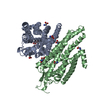
| |||||||||||||||||||||||||||||||||
|---|---|---|---|---|---|---|---|---|---|---|---|---|---|---|---|---|---|---|---|---|---|---|---|---|---|---|---|---|---|---|---|---|---|---|
| 1 | 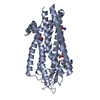
| |||||||||||||||||||||||||||||||||
| 2 | 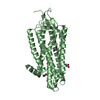
| |||||||||||||||||||||||||||||||||
| Unit cell |
| |||||||||||||||||||||||||||||||||
| Noncrystallographic symmetry (NCS) | NCS domain:
NCS domain segments:
NCS ensembles :
NCS oper: (Code: given Matrix: (-0.8974, -0.09648, 0.4305), Vector: |
- Components
Components
| #1: Protein | Mass: 37381.926 Da / Num. of mol.: 2 / Fragment: RESIDUES 50-272 AND 291-390 / Mutation: YES Source method: isolated from a genetically manipulated source Details: THERMOSTABLE MUTANT WITH INTRACELLULAR LOOP 3 DELETION B (E273-T290) Source: (gene. exp.)   #2: Protein/peptide | Mass: 1087.277 Da / Num. of mol.: 2 / Fragment: C-TERMINUS, RESIDUES 8-13 Source method: isolated from a genetically manipulated source Details: RESIDUES 8-13 CORRESPOND TO NEUROTENSIN C- TERMINUS. RESIDUES 4-7 ARE PART OF AN ARTIFICIAL LINKER AND DO NOT CORRESPOND TO NEUROTENSIN SEQUENCE Source: (gene. exp.)   #3: Chemical | ChemComp-GLY / Has protein modification | Y | Sequence details | CHAINS C AND D - THE SEQUENCE RRPYIL REPRESENTS | |
|---|
-Experimental details
-Experiment
| Experiment | Method:  X-RAY DIFFRACTION / Number of used crystals: 1 X-RAY DIFFRACTION / Number of used crystals: 1 |
|---|
- Sample preparation
Sample preparation
| Crystal | Density Matthews: 3.37 Å3/Da / Density % sol: 63.46 % / Description: NONE |
|---|---|
| Crystal grow | pH: 9.4 / Details: 21.5% (V/V) PEG600, 2 M NACL, 50 MM GLYCINE PH 9.4 |
-Data collection
| Diffraction | Mean temperature: 100 K |
|---|---|
| Diffraction source | Source:  SYNCHROTRON / Site: SYNCHROTRON / Site:  SLS SLS  / Beamline: X06DA / Wavelength: 1 / Beamline: X06DA / Wavelength: 1 |
| Detector | Type: DECTRIS PILATUS / Detector: PIXEL / Date: Aug 6, 2012 |
| Radiation | Protocol: SINGLE WAVELENGTH / Monochromatic (M) / Laue (L): M / Scattering type: x-ray |
| Radiation wavelength | Wavelength: 1 Å / Relative weight: 1 |
| Reflection | Resolution: 2.75→50 Å / Num. obs: 32141 / % possible obs: 99.9 % / Redundancy: 13.1 % / Biso Wilson estimate: 109.97 Å2 / Rmerge(I) obs: 0.08 / Net I/σ(I): 19.85 |
| Reflection shell | Resolution: 2.75→2.84 Å / Redundancy: 13.9 % / Mean I/σ(I) obs: 0.45 / % possible all: 88.7 |
- Processing
Processing
| Software |
| ||||||||||||||||||||||||||||||||||||||||||||||||||||||||||||||||||||||||||||||||||||
|---|---|---|---|---|---|---|---|---|---|---|---|---|---|---|---|---|---|---|---|---|---|---|---|---|---|---|---|---|---|---|---|---|---|---|---|---|---|---|---|---|---|---|---|---|---|---|---|---|---|---|---|---|---|---|---|---|---|---|---|---|---|---|---|---|---|---|---|---|---|---|---|---|---|---|---|---|---|---|---|---|---|---|---|---|---|
| Refinement | Method to determine structure:  MOLECULAR REPLACEMENT MOLECULAR REPLACEMENTStarting model: PDB ENTRY 3ZEV Resolution: 2.75→19.821 Å / SU ML: 0.55 / σ(F): 1.35 / Phase error: 36.94 / Stereochemistry target values: ML / Details: PHENIX AND REFMAC WERE USED.
| ||||||||||||||||||||||||||||||||||||||||||||||||||||||||||||||||||||||||||||||||||||
| Solvent computation | Shrinkage radii: 0.9 Å / VDW probe radii: 1.11 Å / Solvent model: FLAT BULK SOLVENT MODEL | ||||||||||||||||||||||||||||||||||||||||||||||||||||||||||||||||||||||||||||||||||||
| Refinement step | Cycle: LAST / Resolution: 2.75→19.821 Å
| ||||||||||||||||||||||||||||||||||||||||||||||||||||||||||||||||||||||||||||||||||||
| Refine LS restraints |
| ||||||||||||||||||||||||||||||||||||||||||||||||||||||||||||||||||||||||||||||||||||
| Refine LS restraints NCS |
| ||||||||||||||||||||||||||||||||||||||||||||||||||||||||||||||||||||||||||||||||||||
| LS refinement shell |
|
 Movie
Movie Controller
Controller


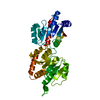
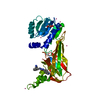
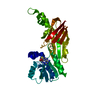

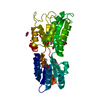

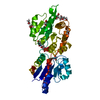

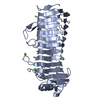
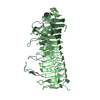
 PDBj
PDBj







